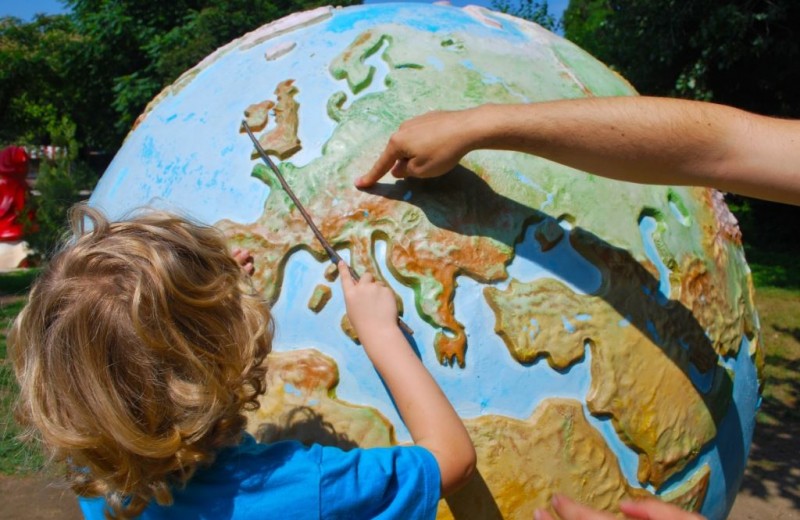
Are you ready to embark on a journey through some fascinating geographic facts that will change the way you perceive the world around you? We've gathered a collection of eye-opening tidbits about our planet's geography that will leave you amazed. From awe-inspiring natural wonders to quirky geographical anomalies, this article will take you on a captivating tour of the Earth's most intriguing features.
The Grand Canyon, located in Arizona, USA, is a monumental chasm that stretches for over 277 miles and plunges to depths of up to 6,093 feet. This breathtaking gorge was carved by the Colorado River over millions of years, revealing rock layers that tell the Earth's geological history.
Mount Everest, towering at 29,032 feet above sea level, is the world's highest peak. Situated in the Himalayas on the border of Nepal and Tibet, this iconic mountain has attracted adventurers and climbers from across the globe, challenging their limits and determination.
The Great Barrier Reef, off the coast of Queensland, Australia, is the largest coral reef system on Earth. It spans over 1,400 miles and is home to an astonishing diversity of marine life. Its vibrant coral formations can even be seen from space.
The Bermuda Triangle, also known as the "Devil's Triangle," is an area in the western part of the North Atlantic Ocean where numerous ships and aircraft have disappeared under mysterious circumstances. Despite extensive research, the exact cause remains a puzzle.
In Bolivia, you'll find the Salar de Uyuni, an otherworldly expanse of salt flats that spans over 4,000 square miles. When covered with a thin layer of water, it creates a stunning mirror effect, making it appear as if you're walking on the sky.
The Dead Sea, located between Israel and Jordan, is known for its extreme salinity, making it nearly impossible for aquatic life to thrive. Its high salt concentration allows you to effortlessly float on its surface, a unique experience for visitors.
Chile's Atacama Desert is often referred to as the driest place on Earth. Some parts of this arid landscape have not seen rainfall for centuries. Its barren beauty and unique geology make it a hotbed for scientific research.
Mawsynram, a village in India, holds the record for being the wettest place on Earth. It receives an average annual rainfall of around 467.4 inches, leading to lush green landscapes and captivating waterfalls.
Death Valley, located in California, USA, is famous for its scorching temperatures. The highest temperature ever recorded on Earth, a blistering 134 degrees Fahrenheit (56.7 degrees Celsius), was registered here in 1913.
The Amazon Rainforest, spanning across nine South American countries, is often referred to as the "lungs of the Earth." It produces 20% of the world's oxygen and is a biodiversity hotspot, housing millions of species, many of which are yet to be discovered.
The Great Wall of China, stretching over 13,000 miles, is one of the most iconic man-made structures globally. It was built over centuries to protect against invasions and stands as a testament to human ingenuity and determination.
The Northern Lights, also known as the Aurora Borealis, grace the night skies in polar regions. These dazzling light displays are caused by charged particles from the sun colliding with the Earth's atmosphere, creating a breathtaking natural spectacle.
The theory of plate tectonics explains how the Earth's lithosphere is divided into several large and small plates that float on the semi-fluid asthenosphere beneath them. The constant movement of these plates results in earthquakes, volcanic eruptions, and the creation of mountain ranges.
Glaciers are massive bodies of ice that store around 69% of the world's freshwater. These slow-moving giants have shaped landscapes and continue to be critical indicators of climate change.
Deforestation, the widespread clearing of forests, poses a significant threat to the Earth's biodiversity. It disrupts ecosystems, contributes to climate change, and endangers countless plant and animal species.
Climate change, driven by human activities such as burning fossil fuels and deforestation, is causing rising temperatures, extreme weather events, and the melting of polar ice. It's a global crisis that requires urgent action to mitigate its effects.
These captivating geographic facts remind us of the remarkable diversity and complexity of our planet. From the awe-inspiring natural wonders to the intriguing geographical anomalies, the Earth continues to amaze and inspire us. It's crucial that we appreciate and protect the beauty and fragility of our world for future generations.
Eat broccoli to strengthen your lungs, you will get relief from respiratory diseases
Planning to give up milk for a month? So know what effect it has on the body!